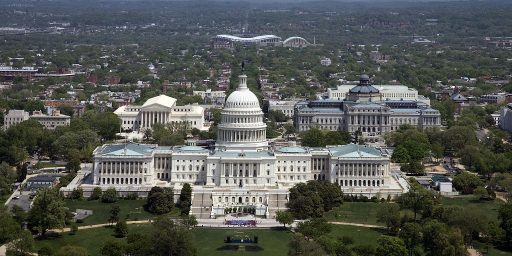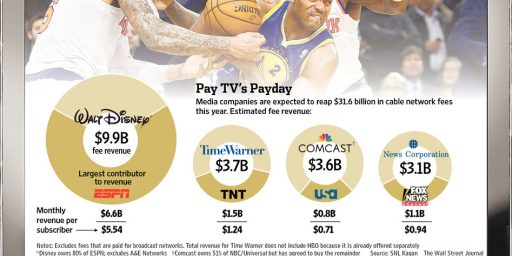Nationalizing the Local
The appetite for content and clicks turns sensationalizes news that isn't news.

Kevin Drum contends, “Trivial local stories will be the death of the national media.” The post is centered around a not-so-trivial story from a county next door to mine that I know about only because people in a Facebook group bandied it about multiple times.
But I agree with Drum’s takeaway:
This is a story that had no place in the national spotlight to begin with. It’s a local story. The real problem is that when they’re politically useful, local stories are routinely blown up onto the national stage these days. Social media has a lot to do with this.¹
One of the mechanical reasons for this is that media in the past had word limits. TV news was 30 minutes long. Newspapers were only as big as advertising allowed. Magazines had set page limits. Local stories from around the country might get blurbs on page A34, but only rarely did they truly become national stories.
Needless to say, the advent of unfettered talk radio, 24-hour cable news, and the internet shattered those limits. Today, reporters see a few hundred people griping about something on Twitter and decide it must be a trend. Political players on both sides are constantly on the lookout for minor local stories that are likely to inflame their audience—and in a country of 300 million they’re guaranteed to find plenty.
I don’t think there’s really anything we can do about this. It’s just life in the 21st century. Nevertheless, let’s get the diagnosis right. It’s not that the national media ignores vital local stories. It’s that the national media is more and more dragged into paying attention to trivial local stories.
I first started noticing the trend shortly after the OJ Simpson murder spree and, in particular, the infamous slow police “chase” involving the white Ford Bronco. For quite some time after that, the cable news channels treated every car chase they could get a helicopter feed of as a national news story.
I’d argue the “pretty blonde girl is missing/kidnapped” genre fits into this bucket as well. They’re not trivial, since they deeply matter to those involved, but they’re not news and they’re certainly not national news.
But, yes, social media amplifies the trend further. These local stories are no longer about getting a ratings spike or generating clicks but about cherry-picking outrageous cases to serve a political or ideological agenda.
There’s also a countervailing trend that I’ve noted the last few years, wherein respectable news outlets generate dozens of stories that are nothing but collections of reactions from randos on Twitter. What Joe from Flower Mound thinks about a given issue isn’t even news in Flower Mound. Aggregating a dozen of them doesn’t change that.






I think it is BOTH about ratings and ideology. The partisan media make a lot of money with the faux outrage of the day. Look at all of the radio talkers. The big money people rake in millions but go to your small local stations. They have lots of small potatoes people making a living, maybe not a killing, spreading this stuff. Making people angry makes money. So sure it helps drive towards a political end but if there wasn’t a lot of money made to pay for all of this I dont think it happens so much.
Steve
It’s also a big part of why people think crime is rampant when it’s actually down. In a nation of 335 million, one in a million stories happen every day. But it’s oddly trendy. For awhile, every carjacking seemed to make the national news. I haven’t seen a carjacking story for a long time. Maybe it ceases to be news once they’ve made it seem commonplace.
This is oddly reinforced by localizing the national. Small-town newspapers have been bought up by state, regional, or even national conglomerates. They don’t have local offices anymore, and rely heavily on press releases rather than going where the story is. There’s very little local news to read–even if you wanted to.
The RSS feed for my “local” newspaper* had a story about Chelsea Football Club. Y’know… Over in England.
==============
* It’s actually the feed for all of the papers in the group, so I’ll see the same story show up half a dozen times or more.
Bring back the good old days.
This is what you get when the economic model for the news media is about getting clicks and “engagement.” And, as we see here even at OTB, culture war and partisan political topics get the most engagement. Therefore, anything that might be even adjacent to the culture war becomes national news. Minimal fact-checking is done. No context is provided outside of the opinion of the reporter’s Twitter bubble.
Any “news” about politics or the culture war coming from American-based organizations ought to be treated as propaganda until proven otherwise. IMO, it really is that bad.
@Mu Yixiao: Years ago coming back from Korea, I bought 3 newspapers at an airport newsstand–the Seattle Post-Intelligencer (as I said, years ago), the Tacoma News Tribune, and one other (forget which one). What was most interesting to me was that the first and 3rd sections (national and sports) were identical in all three papers–same articles on the same pages in the same positions. The even had the same OP/ED pieces (but different letters to the editors).
And for the Tacoma and Seattle papers, even the local/regional section had significant numbers of duplications. Consolidation’s been with us for quite some time. Maybe longer than we realize.
OT- James or Andy or anyone. Giving a Veterans Day speech this year. Does anyone know what percent of officers were prior enlisted? Searched and not had much luck finding a good number.
Steve
steve,
I don’t think there are reliable numbers and it varies a lot by service. The published numbers I’ve seen are the number commissioned via OTS/OCS (about 20% of officer commissions). But of course, a wide variety of people commission via OTS/OCS, not just prior-enlisted. My best guess would be about 5%.
@steve: I’m unaware of anyone who keeps these statistics. As @Andy notes, OCS/OTS isn’t necessarily for prior enlisted, as a lot of services allow that path for college graduates who didn’t/couldn’t participate in ROTC. It’s definitely more common in the Marine Corps than in the Army, and I suspect even lower in the Navy and Air Force.
Thanks guys!
Steve